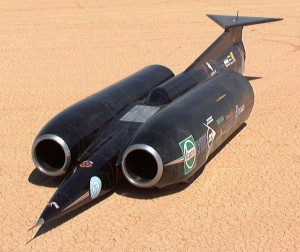Designing a unique vehicle
Recently I read Thrust, the book by Richard Noble on his life in breaking land speed records, culminating in the development of the ThrustSSC car – the current world land speed record holder. The record was achieved in 1997.

The book is outstanding on a number of levels, including its honesty and clarity. The section where driver Any Green describes his techniques for steering the car is just amazing, as is the constant battle for funds that occurred every day of the project.
But one small part of the book particularly interested me: the section where the primary designer Ron Ayers describes how he went about designing the car.
The text is reproduced here:
How do you start designing a vehicle that is totally unique? Here are the characteristics of the problem that faced us:
1. By travelling supersonically on land we would be exploring a region where no-one had ventured, where even the problems could only be guessed at, so there were no known solutions.
2. As the aerodynamic forces involved were so enormous, any accident was likely to be fatal.
3. The project would always be underfunded, short of people and time.
4. There would be only one chance. The final car was also the first prototype. The first lines drawn on paper could well be the ones that are made. The very first assumptions and decisions, if incorrect, could put the project on the wrong track and there would be no chance of starting again.
Problem: how do you make those crucial first decisions when so much is uncertain?
First, every decision had to be a robust one. That meant it couldn’t be invalidated by subsequent decisions.
Second, we could only use technology we were very confident with. This militated against using the very latest technology in some cases.
Third, although direct experience of supersonic travel on land did not exist, we consulted widely, with aviation and automobile experts in industry, universities and research establishments. Experience with Thrust2 was invaluable, particularly in pinpoint¬ing practical and environmental problems that might otherwise be overlooked.
Fourth, where possible we left room for adjust¬ment or change, so we could incorporate knowledge acquired subsequently. Nothing was “hard wired”. One reason for using a steel chassis was that it could be modified if necessary.
Fifth, we didn’t try too hard to integrate the systems. If we needed to change one of them, we didn’t want to be forced to change them all.
Sixth, our choice of a twin-engined car made the design massively overpowered. Thus weight was not a critical factor.
The design resulting from such an approach must necessarily be “sub-optimum”. A second attempt, incorporating the lessons learned, would undoubtedly be better. But the design was proved in practice, and there was little about the basic concept that would need to be changed.
The more you read those notes, the more you realise the clarity of thought being employed: it’s also food for thought for anyone building a unique design of anything.
Noble and Green are currently involved with another land speed record car bid – the Bloodhound SSC.

 Julian Edgar, 50, has been writing about car modification and automotive technology for nearly 25 years. He has owned cars with two, three, four, five, six and eight cylinders; single turbo, twin turbo, supercharged, diesel and hybrid electric drivelines. He lists his transport interests as turbocharging, aerodynamics, suspension design and human-powered vehicles.
Julian Edgar, 50, has been writing about car modification and automotive technology for nearly 25 years. He has owned cars with two, three, four, five, six and eight cylinders; single turbo, twin turbo, supercharged, diesel and hybrid electric drivelines. He lists his transport interests as turbocharging, aerodynamics, suspension design and human-powered vehicles.
